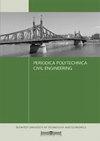局部土体剖面对地震场地反应分析的影响
IF 1.4
4区 工程技术
Q3 ENGINEERING, CIVIL
引用次数: 0
摘要
地震时当地土壤条件对地震波强度变化有重要影响。这些变化可以放大或缩小,取决于具体的土壤条件。本研究旨在评估不同土壤剖面对地震现场反应的影响。该研究考虑了四种类型的场地剖面:砂(Sa)、粘土(Cl)、砂上覆粘土(SaCl)和粘土上覆砂(ClSa)剖面。为了模拟地面运动,我们从欧洲强震数据库中选择了7组强震记录。这些记录是根据Eurocode-8标准选择的,峰值地面加速度(PGA)为0.24 g,使用REXEL计算机程序进行a级站点。然后将这些记录应用于30米深的基岩。随后,使用STRATA进行了一系列1-D等效线性(EQL)响应分析。放大因子(AFs)和表面加速度时程为我们的分析结果提供了定量评价。结果表明,粘土基岩剖面(SaCl和Cl剖面)比砂基岩剖面(Sa和ClSa剖面)表现出更高的地震放大和峰值地面加速度。最大中位数AF是从SaCl站点配置文件中计算出来的,而最小中位数AF是从ClSa配置文件中计算出来的。最大和最小中位AFs的相对差值约为33.7%。基于这些结果,我们可以得出结论,与刚性局部土相比,软土对地震波的放大有明显的影响。本文章由计算机程序翻译,如有差异,请以英文原文为准。
Effects of Local Soil Profiles on Seismic Site Response Analysis
Local soil conditions play a significant role in the intensity variations of seismic waves during earthquakes. These variations can be either amplified or de-amplified depending on the specific soil conditions. This study aimed to assess the impact of different soil profiles on seismic site responses. The study considered four types of site profiles: sand (Sa), clay (Cl), sand overlying clay (SaCl), and clay overlying sand (ClSa) profiles. To simulate the ground motion, we selected seven sets of strong earthquake records from the European Strong-Motion Database. These records were selected according to Eurocode-8 with a peak ground acceleration (PGA) of 0.24 g, site class A using REXEL computer program. The records were then applied to the bedrock at a depth of 30 meters. Subsequently, a series of 1-D equivalent linear (EQL) response analyses were performed using the STRATA. Amplification factors (AFs) and surface acceleration time histories provided quantitative evaluations for our analysis results. The results demonstrated that site profiles with clay overlying bedrock (SaCl and Cl profiles) exhibited higher seismic amplification and peak ground acceleration in comparison to site profiles with sand overlying bedrock (Sa and ClSa profiles). The maximum median AF is calculated from the SaCl site profile, while the minimum median AF was calculated from the ClSa profile. The relative difference between the maximum and the minimum median AFs was about 33.7%. Based on these results, we can conclude that soft local soils have a pronounced effect on the amplification of seismic waves compared to stiff local soils.
求助全文
通过发布文献求助,成功后即可免费获取论文全文。
去求助
来源期刊

Periodica Polytechnica-Civil Engineering
工程技术-工程:土木
CiteScore
3.40
自引率
16.70%
发文量
89
审稿时长
12 months
期刊介绍:
Periodica Polytechnica Civil Engineering is a peer reviewed scientific journal published by the Faculty of Civil Engineering of the Budapest University of Technology and Economics. It was founded in 1957. Publication frequency: quarterly.
Periodica Polytechnica Civil Engineering publishes both research and application oriented papers, in the area of civil engineering.
The main scope of the journal is to publish original research articles in the wide field of civil engineering, including geodesy and surveying, construction materials and engineering geology, photogrammetry and geoinformatics, geotechnics, structural engineering, architectural engineering, structural mechanics, highway and railway engineering, hydraulic and water resources engineering, sanitary and environmental engineering, engineering optimisation and history of civil engineering. The journal is abstracted by several international databases, see the main page.
 求助内容:
求助内容: 应助结果提醒方式:
应助结果提醒方式:


